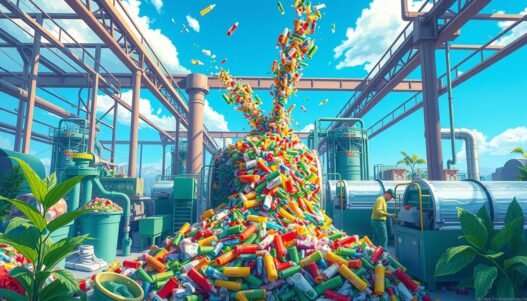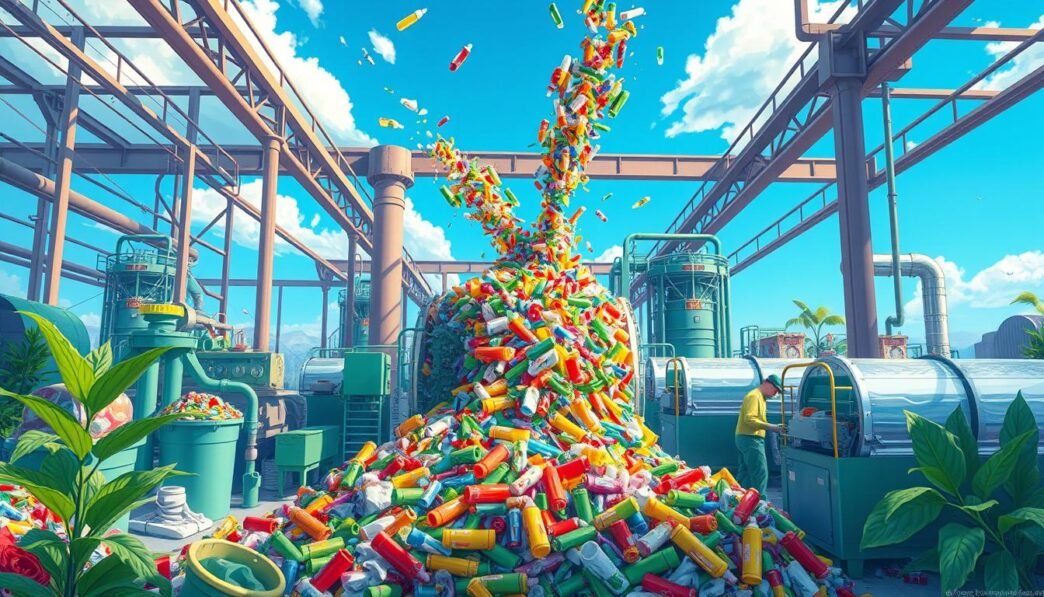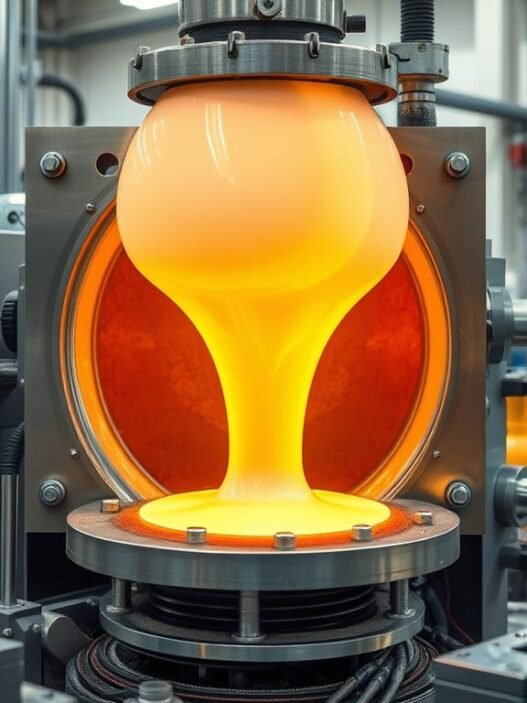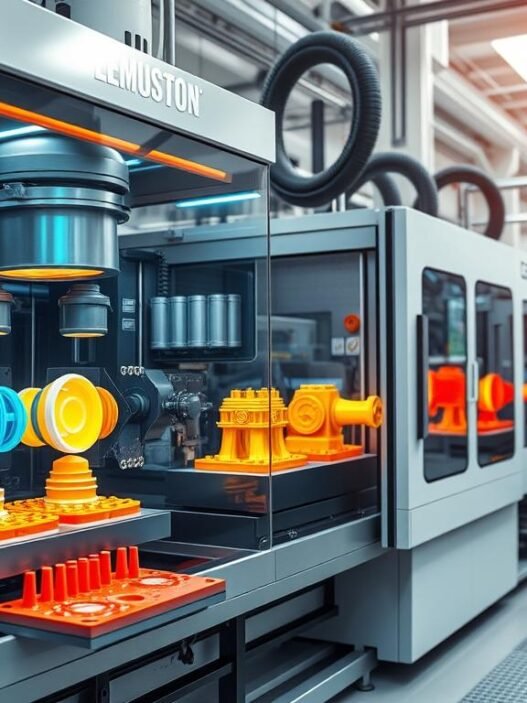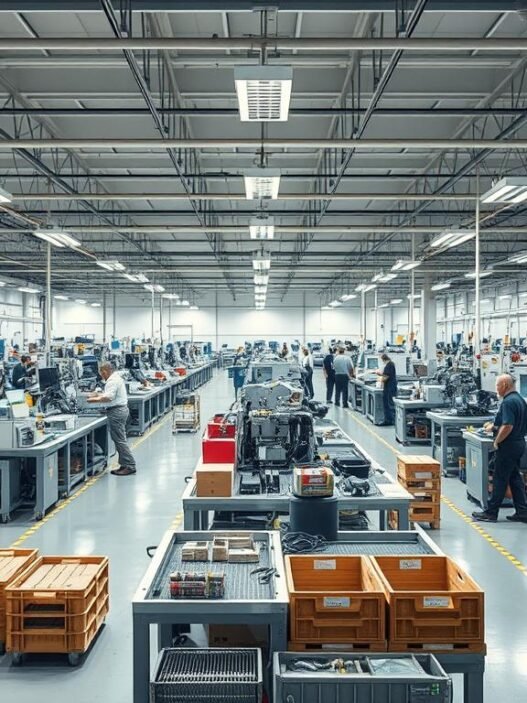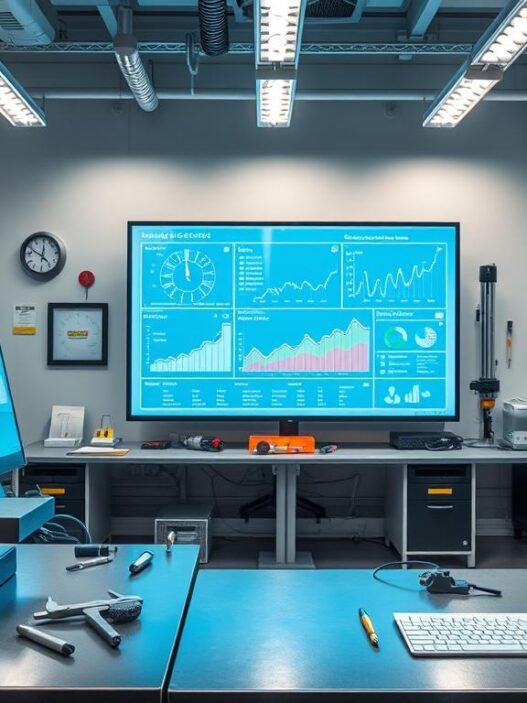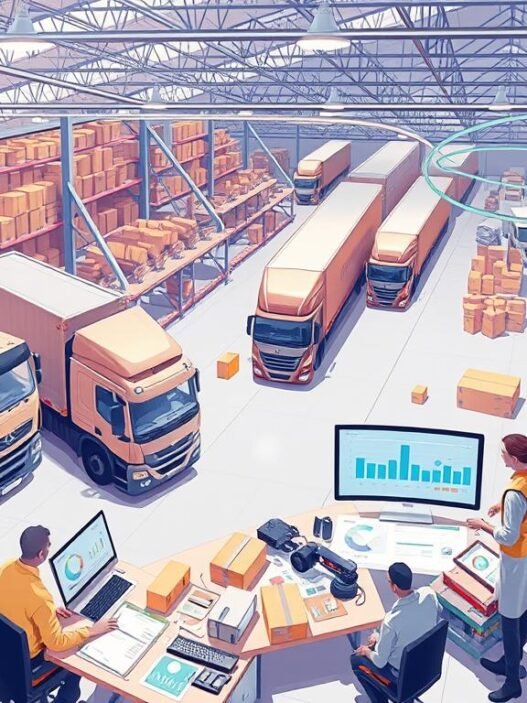In a world filled with growing waste, a big question stands out: How can we manage the mountains of plastic harming our environment? Plastic recycling might hold the key, turning waste into valuable resources. But is recycling enough to tackle the plastic crisis? Let’s dive into the complex world of plastic waste management and find new ways to make sustainability work.
Key Takeaways
- Plastic recycling offers opportunities to reduce oil usage, carbon dioxide emissions, and waste disposal.
- Mechanical and chemical recycling techniques are complementary approaches to plastic waste management.
- Life cycle assessments demonstrate the environmental benefits of chemical recycling compared to incineration and landfilling.
- Innovative recycled plastic products, such as furniture and construction materials, can drive a circular economy.
- Effective waste segregation and source separation are crucial steps towards efficient recycling and resource recovery.
The Rise of Plastic Production and Its Environmental Impact
Plastic is now a big part of our lives, with production soaring in recent years. In 2019, the world made over 460 million metric tons of plastic. This is more than double what was made in 2000. The growing demand for plastic has led to a big environmental problem.
Plastic’s Durability and Non-Biodegradability
Plastic lasts a long time because it’s not biodegradable. This makes it useful in many ways. But, it also means plastic stays in the environment for a very long time. This leads to a lot of waste in landfills and natural places, causing harm.
Accumulation of Plastic Waste in Landfills and Natural Habitats
The OECD says 91% of plastic isn’t recycled. Only about 19% is burned. The rest ends up in landfills or is not handled properly. This is a big problem for the environment.
Things like cigarette butts and food wrappers are common plastic waste. Also, tiny plastics, called microplastics, are everywhere. They pollute water, soil, animals, and even people.
The harm caused by plastic production and pollution is clear. From getting fossil fuels to throwing away single-use plastics, it’s bad for the planet. We need to use less plastic and manage waste better to fix this problem.
The Importance of Recycling Plastics
Recycling is key to lessening the harm plastics cause to our environment. It turns waste into useful resources. This helps cut down on oil use, carbon emissions, and waste that needs to be thrown away.
Reducing Oil Usage, Carbon Dioxide Emissions, and Waste Disposal
Making new plastic products often means using oil and natural gas. Recycling plastics lowers the need for these resources. This leads to less energy use and fewer emissions from extracting and processing raw materials. Recycling one ton of plastic saves 7.4 cubic yards of landfill space.
The recycling process is also more energy-efficient than making new plastic. This is especially true for mechanical recycling. It turns plastic waste into new products with a lower carbon footprint. A pint-sized bottle of water, for example, needs about 2,000 times more energy to make than tap water.
Recycling also means less plastic waste ends up in landfills and incinerators. This reduces methane emissions from landfills and air pollution from incineration.
In short, recycling plastics is vital for our planet. It helps reduce the environmental damage from plastic production and waste. Recycling cuts down on oil use, carbon emissions, and waste disposal. It’s a key step towards a more sustainable future.
An Overview of Plastic Waste Management Strategies
The world is producing and using more plastics than ever before. This has made it clear that we need better ways to manage plastic waste. One good idea is to use less material in products. For example, using lighter packaging instead of heavy ones can cut down on plastic waste.
Reduction in Material Use and Product Reuse
Designing products to be reused or repaired is another smart strategy. This way, fewer products end up in landfills. It helps create a circular economy where products stay in use longer.
Biodegradable Materials and Energy Recovery
Using biodegradable materials and energy recovery are also important. Biodegradable materials come from renewable sources and break down naturally. This reduces the harm plastic waste can cause. Energy recovery turns non-recyclable plastic into energy, keeping it out of landfills and the environment.
By using a mix of reduction, reuse, and new waste management ideas, we can make a big difference. This approach helps us move towards a more sustainable future and tackles the plastic waste problem.
“Plastic waste is one of the most pressing environmental issues of our time, and it requires a multifaceted approach to address it effectively.”
Plastic Recycling: Transforming Waste into Resources
The world is facing a big problem with plastic waste. Recycling plastic is seen as a key solution to this issue. It helps reduce harm to the environment and saves natural resources.
Recycling plastics has many benefits. It uses less oil, cuts down on carbon emissions, and keeps waste out of landfills and oceans. As plastic pollution grows, recycling becomes even more important.
Unlocking the Potential of Plastic Recycling
Plastic recycling involves different methods, each with its own benefits and challenges. The traditional way is mechanical recycling, which breaks down plastic into new products. But, new chemical recycling technologies are also emerging.
These new methods can turn plastic waste into raw materials for many products. They help reduce waste in landfills and cut down on carbon emissions. This is better than burning waste, which is harmful to the environment.
“Recycling can therefore decrease energy and material usage per unit of output and yield improved eco-efficiency.”
To make plastic recycling even better, we need to use these new technologies more. We also need to sort waste better and work together. This will help us use plastic waste more efficiently and create a greener future.
| Key Recycling Statistics | Value |
|---|---|
| India’s annual municipal solid waste generation | 62 million tonnes |
| India’s current plastic waste recycling rate | 30% |
| Informal waste pickers’ contribution to municipal solid waste processing | 20% |
| Potential job creation in the Indian waste management sector by 2025 | 25 million |
Mechanical Recycling: Processes and Limitations
Mechanical recycling is key in the circular economy. It turns plastic waste into new raw materials or products. This method is used in Europe and worldwide to recycle both industrial and post-consumer plastics. Yet, it has some big challenges that affect its efficiency and the quality of recycled plastics.
Sorting mixed and contaminated plastic waste is a big problem. It’s hard to separate different plastics because of their unique properties and additives. This makes the recycling process harder and lowers the value of the recycled plastics.
Another issue is polymer degradation. The recycling process can damage the plastic chains, especially in materials like PET. This limits how many times plastics can be recycled and affects their quality.
- Recycling rates in the U.S. for both PET and HDPE approach 30%, while Canadians recycle 75% of PET beverage bottles.
- Only about 5% of the 1.1 billion pounds of film recovered for recycling comes from curbside recycling programs.
- Retailers accepting flexible packaging via in-store drop-off bins only account for 5% of film collection for recycling.
Despite these challenges, mechanical recycling is crucial for managing plastic waste. It helps reduce landfill waste and saves resources needed for making new plastics. To improve recycling rates, we need better waste sorting and more public involvement in recycling.
“Achieving a 30% recycling rate would reduce the plastics’ carbon footprint by one quarter compared to no recycling.”
The circular economy is growing, and so is the importance of mechanical recycling. We need new solutions and a complete approach to plastic waste management. By tackling these issues and exploring other recycling methods, we can make plastic recycling more sustainable and efficient.
Chemical Recycling: A Complementary Solution
The world is facing a huge plastic waste problem, with 250 million metric tons made every year. Mechanical recycling has its benefits, but it can’t handle all types of plastic waste. Chemical recycling offers a new way to turn plastic waste into useful materials.
Gasification, Pyrolysis, and Depolymerization
Chemical recycling uses gasification, pyrolysis, and depolymerization to break down plastic into its basic parts. These processes turn plastic into raw materials that can be used again. This reduces our need for new, raw materials from fossil resources.
ChemCycling® by BASF is a chemical recycling effort. It works with companies like Quantafuel and ARCUS to use pyrolysis. This turns mixed plastic waste and old tires into raw materials for new products.
Transforming Plastic Waste into Secondary Raw Materials
The plastics made through chemical recycling can be used in many industries. This includes food packaging, medical, textile, and automotive. It helps reduce plastic waste and saves natural resources.
Chemical recycling is better for the environment than burning or landfilling plastic. For example, it cuts carbon emissions by 28% and fossil resource use by 66% for polypropylene.
Even though chemical recycling has challenges, it’s a key part of solving the plastic waste problem. It offers a way to manage plastic waste more effectively.
| Key Advantages of Chemical Recycling | Potential Challenges |
|---|---|
|
|

“Chemical recycling provides a reduction in greenhouse gas (GHG) emissions of at least 50% (2023) and 60% (2030) when replacing incineration of waste plastic with chemical recycling.”
Life Cycle Assessment: Environmental Benefits of Chemical Recycling
Studies have shown that chemical recycling is better for the environment than traditional waste management. Chemical recycling, especially pyrolysis, has a lower carbon footprint than burning or landfilling plastic waste.
A Cefic-Quantis LCA report found pyrolysis emits less CO2 than burning plastic waste. The steam cracker and polymerization processes also play a big role. They can be improved to lower chemical recycling’s carbon footprint even more.
Changes in how materials are used at the end of their life greatly impact the environment. This includes freshwater and resource use. It’s important to look at the whole life cycle to understand chemical recycling’s benefits.
| Process | Environmental Burden Share |
|---|---|
| Pyrolysis | 26.0% |
| Steam Cracker | 30.4% |
| Polymerization | 30.6% |
| Pre-treatment | 13.1% |
Chemical recycling is better than traditional methods when using certain factors. The Net Scrap method of chemical recycling has the lowest environmental impact. This is compared to the EoL Recycling method.
Improving the pyrolysis process and exploring new options could reduce environmental impact. This includes using different plastics and adding catalysts in plants.
“Chemical recycling can help reduce landfill and the leakage of plastics into the environment, making it a more environmentally responsible solution for managing plastic waste.”
Innovative Solutions for Recycled Plastic Products
The world is moving towards a circular economy for plastic waste. This shift has led to new ways to use recycled plastic. Entrepreneurs and small businesses are leading this change. They focus on using locally sourced and produced recycled plastic.
Business Plans for Locally Sourced and Produced Products
The IUCN Plastic Waste Free Islands project has created eight business plans. These plans show how recycled plastic can be used. They cover everything from sorting waste to making final products.
The plans aim to make furniture, construction materials, and reusable food containers. They use recycled plastic from local sources.
Furniture, Construction Materials, and Reusable Food Containers
The IUCN project’s business plans show recycled plastic’s versatility. Companies use new sorting methods and digital tools to make high-quality materials. These materials are then turned into various products.
These products include furniture, construction materials, and food containers. They help reduce environmental harm and support a circular economy.
| Product | Material | Recycling Process | Environmental Benefits |
|---|---|---|---|
| Watering Can | Recycled Plastic Bottles | Mechanical Recycling | Reduced Waste, Conserved Resources |
| Insulating Material | Agricultural and Forestry By-products | Compostable Material | Sustainable Alternative to Polystyrene |
| Compostable Packaging | Plant Residues | Sustainable Manufacturing | Chemical-free, Environmentally Friendly |
These solutions show the power of recycled plastic products. By using local materials and new recycling tech, businesses make eco-friendly products. These products help the circular economy.
“Collaboration between industries, governments, and NGOs is increasing to promote plastic recycling initiatives.”
Bottle-to-Bottle Recycling: Closing the Loop
The beverage industry is working hard to make our future greener. They’re focusing on bottle-to-bottle recycling and closed-loop recycling. This method turns old bottles into new ones, reducing waste and helping our planet.
Projects like the Bottle-to-Bottle Tokyo Project, GREEN SEA Setouchi Hiroshima Platform, and the Kanagawa PET Bottle Model Business Promotion Consortium are leading the way. They bring together local governments, schools, and the beverage industry. Together, they raise awareness, improve recycling systems, and test new recycling tech.
- The Bottle-to-Bottle Tokyo Project sets up educational booths and conducts classes. They also test new recycling equipment.
- The GREEN SEA Setouchi Hiroshima Platform works to keep PET bottles out of the ocean. They do field tests, workshops, and segregated collection.
- The Kanagawa PET Bottle Model Business Promotion Consortium helps share knowledge. They advance recycling in Kanagawa Prefecture.
These projects are showing great results. They’ve raised awareness, found effective recycling methods, and cut down on ocean pollution. Thanks to teamwork and green practices, the industry is moving towards a future where recycling is the standard.
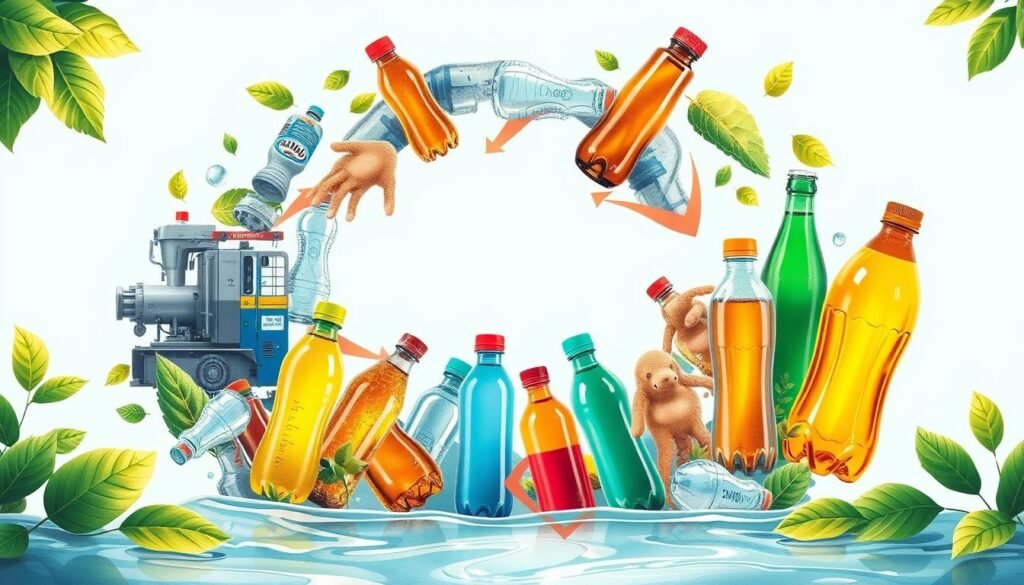
The world is facing big challenges from plastic waste. But the beverage industry’s efforts in recycling show us the power of teamwork and innovation. They’re leading the way towards a more sustainable future.
Waste Segregation: A Crucial Step Towards Efficient Recycling
Starting to recycle plastic well begins with sorting waste at its source. Without good sorting, recycling fails, and materials end up in landfills or burned. The Plastic Waste Free Islands project has made a guide to help change how we manage waste.
Source Segregation for Improved Waste Management
Sorting waste at the source makes recycling easier and helps move towards a circular economy. By separating recyclables, organic waste, and non-recyclables, we can process materials better. This method also helps waste management systems and creates jobs, especially in small islands and developing countries.
Unlocking the Value of Waste and Moving Towards Circularity
Optimizing waste management through source segregation unlocks waste’s value and moves us towards a circular economy. This means keeping recyclables out of landfills and using them again in making new products. It saves natural resources, cuts down on greenhouse gases, and reduces waste’s environmental harm.
Effective waste segregation is key to a sustainable and efficient future. As we tackle the global waste problem, adopting this practice can unlock plastic recycling’s full potential. It brings us closer to a circular economy.
“Proper waste segregation is the cornerstone of an efficient recycling system. By separating materials at the source, we can maximize the recovery and reuse of valuable resources, ultimately moving towards a more sustainable future.”
Conclusion
Plastic recycling is key to a circular economy. It aims to use resources over and over again, reducing waste. By using both mechanical and chemical recycling, we can turn plastic waste into something valuable.
Everyone can help by recycling more. This includes the public, businesses, and governments. Together, we can make a big difference in keeping our planet clean.
Small actions can add up. Choosing items that can be recycled, like cardboard and aluminum, helps a lot. Bans on plastic bags and the removal of microbeads from products also show progress.
Improving recycling systems and finding new ways to recycle is important. This will help us move towards a better future. With these steps, we can make our world more sustainable.





